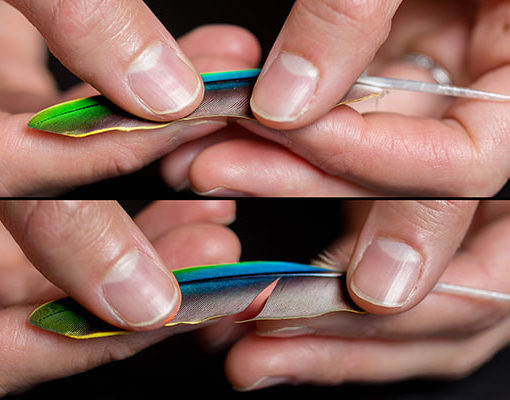
From Nuts and Bolts to Turbine EnginesThe global economic impact of corrosion is estimated at $2.5 trillion, globally, and effective corrosion prevention can save lives by avoiding catastrophic events.Super-thin oxide films may protect metals from corrosion, and traditionally, these protective films have been viewed as simple oxides of well-anticipated compounds, but scientists at Northwestern University, the University of Virginia, and the University of Wisconsin-Madison teamed up using state-of-the-art experimental techniques and theoretical modeling to analyze oxide films at the atomic level, deciphering how the atoms are arranged in these oxides. They discovered that the protective films develop new structures and compositions that depend on how fast the oxide film grows. These findings may provide clues regarding how to significantly improve these protective films. The study was published Oct. 3, 2018 by the journal Physical Review Letters. Laurence Marks, professor of materials science and engineering at Northwestern’s McCormick School of Engineering led the study. “The real promise is going to be creation of new alloys where we deliberately exploit how the oxide grows to produce ones which have better, hopefully substantially better corrosion resistance,” he said in an interview with Innov8 Updates. The team studied oxides that form on alloys composed of nickel and chromium, which are widely used in a variety of products, such as the heating elements of a household toaster or in aircraft engines. These oxides are also used for applications such as in dental implants, where water is present. These oxides work when hot and resist corrosion in the mouth because of the formation of an oxide of chromium. It was assumed that the nickel formed a separate oxide, or in some cases dissolved away in the body. Why? Because the nickel atoms do not have time to escape from the oxide, becoming captured inside it. The fraction that is captured depends upon how fast the oxide grows. If it grows very slowly, the nickel atoms can escape. If it grows very fast, they cannot. This occurs both when the metals are reacting with oxygen from the air at high temperatures, as well as when they are reacting with water in ships or in dental implants. The atoms that are captured in the oxide change many of the properties, the study’s authors say. The findings mean it is possible to deliberately trap atoms into these oxides in new ways, and thus change how they behave. The understanding of oxide layers may not only lead to better metals and less corrosion but could affect development of electronics and other products. According to the study: “We suspect solute capture occurs in other solid-fluid or solid-solid chemical reactions, not just the formation of protective oxide films or rapid solidification. If the product is lower in free energy, and the reaction front is moving fast enough, the same science holds independent of whether one is dealing with ceramics, metals, semiconductors or polymers.” Works Consulted |
|

From Nuts and Bolts to Turbine EnginesThe global economic impact of corrosion is estimated at $2.5 trillion, globally, and effective corrosion prevention can save lives by avoiding catastrophic events.Super-thin oxide films may protect metals from corrosion, and traditionally, these protective films have been viewed as simple oxides of well-anticipated compounds, but scientists at Northwestern University, the University of Virginia, and the University of Wisconsin-Madison teamed up using state-of-the-art experimental techniques and theoretical modeling to analyze oxide films at the atomic level, deciphering how the atoms are arranged in these oxides. They discovered that the protective films develop new structures and compositions that depend on how fast the oxide film grows. These findings may provide clues regarding how to significantly improve these protective films. The study was published Oct. 3, 2018 by the journal Physical Review Letters. Laurence Marks, professor of materials science and engineering at Northwestern’s McCormick School of Engineering led the study. “The real promise is going to be creation of new alloys where we deliberately exploit how the oxide grows to produce ones which have better, hopefully substantially better corrosion resistance,” he said in an interview with Innov8 Updates. The team studied oxides that form on alloys composed of nickel and chromium, which are widely used in a variety of products, such as the heating elements of a household toaster or in aircraft engines. These oxides are also used for applications such as in dental implants, where water is present. These oxides work when hot and resist corrosion in the mouth because of the formation of an oxide of chromium. It was assumed that the nickel formed a separate oxide, or in some cases dissolved away in the body. Why? Because the nickel atoms do not have time to escape from the oxide, becoming captured inside it. The fraction that is captured depends upon how fast the oxide grows. If it grows very slowly, the nickel atoms can escape. If it grows very fast, they cannot. This occurs both when the metals are reacting with oxygen from the air at high temperatures, as well as when they are reacting with water in ships or in dental implants. The atoms that are captured in the oxide change many of the properties, the study’s authors say. The findings mean it is possible to deliberately trap atoms into these oxides in new ways, and thus change how they behave. The understanding of oxide layers may not only lead to better metals and less corrosion but could affect development of electronics and other products. According to the study: “We suspect solute capture occurs in other solid-fluid or solid-solid chemical reactions, not just the formation of protective oxide films or rapid solidification. If the product is lower in free energy, and the reaction front is moving fast enough, the same science holds independent of whether one is dealing with ceramics, metals, semiconductors or polymers.” Works Consulted |
|

From Nuts and Bolts to Turbine EnginesThe global economic impact of corrosion is estimated at $2.5 trillion, globally, and effective corrosion prevention can save lives by avoiding catastrophic events.Super-thin oxide films may protect metals from corrosion, and traditionally, these protective films have been viewed as simple oxides of well-anticipated compounds, but scientists at Northwestern University, the University of Virginia, and the University of Wisconsin-Madison teamed up using state-of-the-art experimental techniques and theoretical modeling to analyze oxide films at the atomic level, deciphering how the atoms are arranged in these oxides. They discovered that the protective films develop new structures and compositions that depend on how fast the oxide film grows. These findings may provide clues regarding how to significantly improve these protective films. The study was published Oct. 3, 2018 by the journal Physical Review Letters. Laurence Marks, professor of materials science and engineering at Northwestern’s McCormick School of Engineering led the study. “The real promise is going to be creation of new alloys where we deliberately exploit how the oxide grows to produce ones which have better, hopefully substantially better corrosion resistance,” he said in an interview with Innov8 Updates. The team studied oxides that form on alloys composed of nickel and chromium, which are widely used in a variety of products, such as the heating elements of a household toaster or in aircraft engines. These oxides are also used for applications such as in dental implants, where water is present. These oxides work when hot and resist corrosion in the mouth because of the formation of an oxide of chromium. It was assumed that the nickel formed a separate oxide, or in some cases dissolved away in the body. Why? Because the nickel atoms do not have time to escape from the oxide, becoming captured inside it. The fraction that is captured depends upon how fast the oxide grows. If it grows very slowly, the nickel atoms can escape. If it grows very fast, they cannot. This occurs both when the metals are reacting with oxygen from the air at high temperatures, as well as when they are reacting with water in ships or in dental implants. The atoms that are captured in the oxide change many of the properties, the study’s authors say. The findings mean it is possible to deliberately trap atoms into these oxides in new ways, and thus change how they behave. The understanding of oxide layers may not only lead to better metals and less corrosion but could affect development of electronics and other products. According to the study: “We suspect solute capture occurs in other solid-fluid or solid-solid chemical reactions, not just the formation of protective oxide films or rapid solidification. If the product is lower in free energy, and the reaction front is moving fast enough, the same science holds independent of whether one is dealing with ceramics, metals, semiconductors or polymers.” Works Consulted |
|



